#writing: guide
Explore tagged Tumblr posts
Text
Tips for writing those gala scenes, from someone who goes to them occasionally:
Generally you unbutton and re-button a suit coat when you sit down and stand up.
You’re supposed to hold wine or champagne glasses by the stem to avoid warming up the liquid inside. A character out of their depth might hold the glass around the sides instead.
When rich/important people forget your name and they’re drunk, they usually just tell you that they don’t remember or completely skip over any opportunity to use your name so they don’t look silly.
A good way to indicate you don’t want to shake someone’s hand at an event is to hold a drink in your right hand (and if you’re a woman, a purse in the other so you definitely can’t shift the glass to another hand and then shake)
Americans who still kiss cheeks as a welcome generally don’t press lips to cheeks, it’s more of a touch of cheek to cheek or even a hover (these days, mostly to avoid smudging a woman’s makeup)
The distinctions between dress codes (black tie, cocktail, etc) are very intricate but obvious to those who know how to look. If you wear a short skirt to a black tie event for example, people would clock that instantly even if the dress itself was very formal. Same thing goes for certain articles of men’s clothing.
Open bars / cash bars at events usually carry limited options. They’re meant to serve lots of people very quickly, so nobody is getting a cosmo or a Manhattan etc.
Members of the press generally aren’t allowed to freely circulate at nicer galas/events without a very good reason. When they do, they need to identify themselves before talking with someone.
#late night thoughts#are these helpful at all?#obv these aren’t applicable to every gala scene#galas#writing tips#writing guide#these don’t apply as much in Gotham obvs#but that’s because it’s Gotham
89K notes
·
View notes
Text
HOW TO WRITE A CHARACTER WHO IS IN PAIN
first thing you might want to consider: is the pain mental or physical?
if it’s physical, what type of pain is it causing? — sharp pain, white-hot pain, acute pain, dull ache, throbbing pain, chronic pain, neuropathic pain (typically caused by nerve damage), etc
if it’s mental, what is the reason your character is in pain? — grief, heartbreak, betrayal, anger, hopelessness, fear and anxiety, etc
because your character will react differently to different types of pain
PHYSICAL PAIN
sharp and white-hot pain may cause a character to grit their teeth, scream, moan, twist their body. their skin may appear pale, eyes red-rimmed and sunken with layers of sweat covering their forehead. they may have tears in their eyes (and the tears may feel hot), but they don’t necessarily have to always be crying.
acute pain may be similar to sharp and white-hot pain; acute pain is sudden and urgent and often comes without a warning, so your character may experience a hitched breathing where they suddenly stop what they’re doing and clench their hand at the spot where it hurts with widened eyes and open mouth (like they’re gasping for air).
dull ache and throbbing pain can result in your character wanting to lay down and close their eyes. if it’s a headache, they may ask for the lights to be turned off and they may be less responsive, in the sense that they’d rather not engage in any activity or conversation and they’d rather be left alone. they may make a soft whimper from their throat from time to time, depends on their personality (if they don’t mind others seeing their discomfort, they may whimper. but if your character doesn’t like anyone seeing them in a not-so-strong state, chances are they won’t make any sound, they might even pretend like they’re fine by continuing with their normal routine, and they may or may not end up throwing up or fainting).
if your character experience chronic pain, their pain will not go away (unlike any other illnesses or injuries where the pain stops after the person is healed) so they can feel all these types of sharp pain shooting through their body. there can also be soreness and stiffness around some specific spots, and it will affect their life. so your character will be lucky if they have caretakers in their life. but are they stubborn? do they accept help from others or do they like to pretend like they’re fine in front of everybody until their body can’t take it anymore and so they can no longer pretend?
neuropathic pain or nerve pain will have your character feeling these senses of burning, shooting and stabbing sensation, and the pain can come very suddenly and without any warning — think of it as an electric shock that causes through your character’s body all of a sudden. your character may yelp or gasp in shock, how they react may vary depends on the severity of the pain and how long it lasts.
EMOTIONAL PAIN
grief can make your character shut themself off from their friends and the world in general. or they can also lash out at anyone who tries to comfort them. (five states of grief: denial, anger, bargaining, depression and eventual acceptance.)
heartbreak — your character might want to lock themself in a room, anywhere where they are unseen. or they may want to pretend that everything’s fine, that they’re not hurt. until they break down.
betrayal can leave a character with confusion, the feelings of ‘what went wrong?’, so it’s understandable if your character blames themself at first, that maybe it’s their fault because they’ve somehow done something wrong somewhere that caused the other character to betray them. what comes after confusion may be anger. your character can be angry at the person who betrayed them and at themself, after they think they’ve done something wrong that resulted in them being betrayed, they may also be angry at themself next for ‘falling’ for the lies and for ‘being fooled’. so yes, betrayal can leave your character with the hatred that’s directed towards the character who betrayed them and themself. whether or not your character can ‘move on and forgive’ is up to you.
there are several ways a character can react to anger; they can simply lash out, break things, scream and yell, or they can also go complete silent. no shouting, no thrashing the place. they can sit alone in silence and they may cry. anger does make people cry. it mostly won’t be anything like ‘ugly sobbing’ but your character’s eyes can be bloodshot, red-rimmed and there will be tears, only that there won’t be any sobbing in most cases.
hopelessness can be a very valid reason for it, if you want your character to do something reckless or stupid. most people will do anything if they’re desperate enough. so if you want your character to run into a burning building, jump in front of a bullet, or confess their love to their archenemy in front of all their friends, hopelessness is always a valid reason. there’s no ‘out of character’ if they are hopeless and are desperate enough.
fear and anxiety. your character may be trembling, their hands may be shaky. they may lose their appetite. they may be sweaty and/or bouncing their feet. they may have a panic attack if it’s severe enough.
and I think that’s it for now! feel free to add anything I may have forgotten to mention here!
#how to#writers on writing#writing#whump#writer#whumpblr#writers#writeblr#angst#writing guide#writing resources#writing challenge#writing inspo#writing inspiration#whump prompts#whump prompt#writing tropes#writing trope#ao3#archive of our own#fanfic#blorbo#comfort character#fanfiction#tropes#trope#whump tropes#prompts#prompt#whump trope
14K notes
·
View notes
Text
PSA to all historical fiction/fantasy writers:
A SEAMSTRESS, in a historical sense, is someone whose job is sewing. Just sewing. The main skill involved here is going to be putting the needle into an out of the fabric. They’re usually considered unskilled workers, because everyone can sew, right? (Note: yes, just about everyone could sew historically. And I mean everyone.) They’re usually going to be making either clothes that aren’t fitted (like shirts or shifts or petticoats) or things more along the lines of linens (bedsheets, handkerchiefs, napkins, ect.). Now, a decent number of people would make these things at home, especially in more rural areas, since they don’t take a ton of practice, but they’re also often available ready-made so it’s not an uncommon job. Nowadays it just means someone whose job is to sew things in general, but this was not the case historically. Calling a dressmaker a seamstress would be like asking a portrait painter to paint your house
A DRESSMAKER (or mantua maker before the early 1800s) makes clothing though the skill of draping (which is when you don’t use as many patterns and more drape the fabric over the person’s body to fit it and pin from there (although they did start using more patterns in the early 19th century). They’re usually going to work exclusively for women, since menswear is rarely made through this method (could be different in a fantasy world though). Sometimes you also see them called “gown makers”, especially if they were men (like tailors advertising that that could do both. Mantua-maker was a very feminized term, like seamstress. You wouldn’t really call a man that historically). This is a pretty new trade; it only really sprung up in the later 1600s, when the mantua dress came into fashion (hence the name).
TAILORS make clothing by using the method of patterning: they take measurements and use those measurements to draw out a 2D pattern that is then sewed up into the 3D item of clothing (unlike the dressmakers, who drape the item as a 3D piece of clothing originally). They usually did menswear, but also plenty of pieces of womenswear, especially things made similarly to menswear: riding habits, overcoats, the like. Before the dressmaking trade split off (for very interesting reason I suggest looking into. Basically new fashion required new methods that tailors thought were beneath them), tailors made everyone’s clothes. And also it was not uncommon for them to alter clothes (dressmakers did this too). Staymakers are a sort of subsect of tailors that made corsets or stays (which are made with tailoring methods but most of the time in urban areas a staymaker could find enough work so just do stays, although most tailors could and would make them).
Tailors and dressmakers are both skilled workers. Those aren’t skills that most people could do at home. Fitted things like dresses and jackets and things would probably be made professionally and for the wearer even by the working class (with some exceptions of course). Making all clothes at home didn’t really become a thing until the mid Victorian era.
And then of course there are other trades that involve the skill of sewing, such as millinery (not just hats, historically they did all kinds of women’s accessories), trimming for hatmaking (putting on the hat and and binding and things), glovemaking (self explanatory) and such.
TLDR: seamstress, dressmaker, and tailor are three very different jobs with different skills and levels of prestige. Don’t use them interchangeably and for the love of all that is holy please don’t call someone a seamstress when they’re a dressmaker
#sewing#historical sewing#sewing knowledge#writing guide#PSA to writers#historical fiction#fantasy writing
18K notes
·
View notes
Text
Developing Backstory: Bringing Characters to Life

1. Where It All Started: The Character’s Origin
Place of Birth: Where did your character first see the world? Think about the impact of this place—was it a busy city where they had to fight for attention or a quiet village where everyone knew everyone’s business? This location doesn’t just say where they’re from; it shapes how they see the world.
Family and Upbringing: What was their family like? Were their parents loving or distant? Maybe they were raised by someone other than their parents—a mentor, an older sibling, or even alone. Family (or the lack of it) is usually one of the most significant factors in shaping who someone becomes.
Society’s Expectations: What was expected of them when they were young? Possibly, they were born into wealth, with all the pressure to continue the family legacy, or maybe they were raised to be invisible in a world where survival mattered. How does this influence who they are now? Do they accept or reject those expectations?

2. Childhood Events That Left a Mark
First Taste of Conflict: Think about the first time the character realized the world wasn’t a perfect place. Maybe they witnessed violence or faced betrayal. What was that moment, and how did it stick with them? This moment usually lays the foundation for the character’s emotional landscape—fear, hope, ambition, or distrust all come from these early life lessons.
Childhood Dreams: When they were young, what did they want to be? Every child has dreams—did they want to be a knight, a scholar, or even just someone who could travel the world? Did they have to give up these dreams? How does that lost dream shape them now?
Formative Relationships: Who was their first best friend, mentor, or enemy? Childhood friendships and relationships often create deep bonds or wounds that last into adulthood. Did they have a mentor who taught them everything, only to betray them? Did they lose a childhood friend that still haunts them?

3. The Teen Years: Where They Start to Become Who They Are
Trials and Tribulations: What’s the biggest challenge they faced as they grew up? Was it losing a loved one, failing at something important, or maybe being forced into a role they didn’t want? These teenage years are where the emotional armor starts forming—how did the difficulties they faced shape them into the person they are now?
Education or Training: How did they learn what they know? Were they formally trained by an institution, learning everything by the book, or did they learn through experience, like a street-smart survivalist? What impact does their education or lack of it have on how they interact with others?
Teenage Bonds: Did they have a first love or a first major falling out with someone close to them? These experiences often create emotional scars or connections that they carry with them into adulthood. How does that past friendship or romance influence their behavior now?

4. Key Life Events: The Big Moments That Define Them
Trauma or Loss: Was there a moment that changed everything? Think about a significant loss—maybe a loved one, their home, or a sense of identity. How does this event affect their worldview? Do they build walls around themselves or dive into relationships with reckless abandon because they fear losing more?
Victory or Failure: Did they experience a moment of triumph or devastating defeat? Success and failure leave their marks. Were they celebrated as a hero once, leading them to overconfidence, or did they fail when everyone was counting on them, leading to crippling self-doubt?
Betrayal: Was there a betrayal that shaped their adult relationships? Whether it is a friend, family member, or lover, betrayal often changes how we trust others. Do they close themselves off, constantly expecting betrayal, or try to rebuild trust, afraid of being left alone again.

5. Where They Stand Now: The Present Moment
What Drives Them Today: What’s the one thing pushing them forward now? Is it revenge, the need to restore their family’s honor, or maybe even just survival? Whatever it is, this motivation should tie directly back to their experiences.
Emotional Baggage: What unresolved emotional wounds are they carrying? Everyone has scars from their past—some are visible, others not so much. How do these emotional wounds affect how they treat others, how they react to conflict, and how they move through the world.
Current Relationships: Who’s still in their life from their past, and how do they feel about it? Did they reconnect with someone they thought they’d lost, or are they haunted by unresolved issues with people from their past? Do they have any ongoing tensions or regrets tied to these people?

6. Tying Themes to Their Backstory
Cultural or Mythological Influence: How does their personal story tie into the larger world’s mythology or culture? Do they carry a family legacy, a curse, or a prophecy that hangs over them? How does this influence their interactions with others and their perception of themselves?
Recurring Symbols: Are there objects, dreams, or people that keep showing up in their life, symbolizing their journey? Perhaps a recurring nightmare haunts them, or they carry an object from their past that’s both a source of comfort and pain

7. Character Arc: The Journey from Past to Present
How Does Their Past Shape Their Growth?: Every character has emotional baggage that needs resolving. How does their backstory drive their arc? Do they need to forgive themselves, let go of the past, or accept who they’ve become to move forward?
Unanswered Questions from the Past: Are there any mysteries in their backstory they need to solve? Maybe they’re unaware of their true parentage, or maybe there’s a forgotten event from their childhood that will resurface and change everything.
#writerscommunity#character backstory guide#writer community#writerscorner#creative writers#writeblr#writerblr#writers on tumblr#writers#free resources#tips and tricks#writing advice#fantasy writing#fiction writing#tumblr writing community#writing a book#writing#writing guide#story writing#writing help#writing resources#writing stuff
4K notes
·
View notes
Text
HOW TO WRITE ROMANTIC ATTRACTION FOR DUMMIES
For anyone who wants to learn, (especially aro/ACE, aspec, ect.)
Requested by the lovely @darkandstormydolls
Alrighty! Welcome back or welcome to my blog! I'm dipping my toes back into the category of posts that gained me my exposure!
So if you're here, you want to know how to write romantic attraction/romance!
Strap in and let's begin!

(Pls spread this to people you think would benefit from seeing it, or anyone who requested it bc I forgot, ANY ASPECS)
Step one -
Your characters must admire one another at the beginning, Romantic feelings usually do not present themselves as obvious until you really think them through, meaning your characters may not notice they have a crush until it's too late
These are general statistics and light stereotypes. So feel free to not use this tip:
Male characters usually tend to notice physical things first, like body shape, hair, skin, clothing, the way their lover moves, ect
And Female Characters Generally tend to notice more small things and personality-based traits first, like their lover's humor, speaking mannerisms, shifts in expression, ways they fidget, emotion in their voice, ect.
And someone who is in love will generally show more interest in this particular person's movements, actions, words, and anything in general.
Step 2 -
The character will show more interest in sharing their love language with their lover/crush
Physical touch - People with physical touch love languages may want to hold hands, cuddle, hug, or just lean on their crush whenever they are close to them moreso than they want to with others
Gift giving - Gift givers will want to get more gifts more often for their crush, probably thinking of them whenever they see little trinkets or wanting to get them big gifts for special occasions or signs of appreciation
Acts of Service - Acts of service people will offer to do extra favors and a bunch of extra stuff they don't have to do twice as much as normal
Words of Affirmation - Flattery, they will generally flood their crush with kind words and compliments
Quality time - Quality time people will want to spend time with their crush at almost every turn, and when they want company, will turn to their crush first
Step 3 -
After a while, these urges while become very prominent and more noticeable to the person having them
They may find themselves fantasizing about their crush or having them show up in their thoughts more and more, feeling nicer and happier when they're around, or when they're thinking about them
Smiling when they think about them, cutsey little fluff thingies like that
A crush is essentially: I want to date that, I want to be near that always, I want to marry that, I want that to snuggle me (or other love languages)
Or in simpler terms: if that asked me out, I would say yes (or at least want to say yes if your character is in denial)
Step 4 -
The character's urges to be close to this person grows strong enough that they do smth about it, whether prompted by another character. Or they just don't know I how to not anymore (like when you wanna eat candy and you don't want to, but you do anyway bc I JUST NEED THE CHOCOLATE OKAY?)
(Or for Aro/Ace, garlic bread)
People who are in love are generally very prone to be all dreamy and poetic and VERY EXTREMELY BIASED towards their crush
Then Yada Yada they kiss & shit
You're welcome, BYEEEEEEEE 👋
Happy writing!
Love you! Thanks for reading, And Ghost Tumblr Mother says go drink some water and have a snack, you've earned it, and you are beautiful <333
Have a good day! :]
@blue-kyber @thisisntrocket @cosmolumine @i-do-anything-but-write @paeliae-occasionally
@supercimi @the-letterbox-archives @sunglasses-in-the-bentley @vyuntspakhkite-l-darling @artsandstoriesandstuff
@corinneglass @wyked-ao3 @urnumber1star
#ellia writes#ellia's rambling#ellia's haunted house#ghost party#creative writing#fiction writing#writing community#writer things#writerscommunity#writers on tumblr#writeblr#writing#writers#writer#asexuals writing romance#aspec writing romance#aro/ace writing romance#writing romance#romance writing tips#romance writing#writing tips#writing guide#romantic attraction
4K notes
·
View notes
Text
Fantasy Guide to Building A Culture
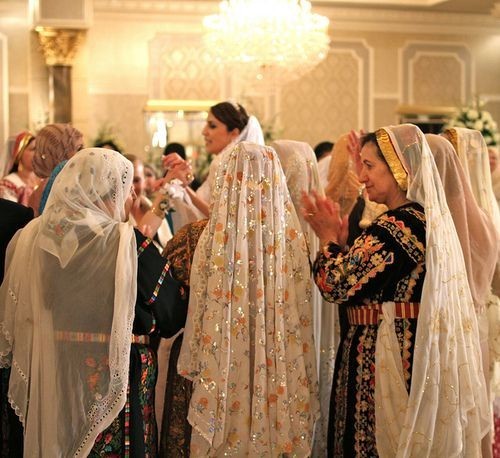
Culture is defined by a collection of morals, ethics, traditions, customs and behaviours shared by a group of people.
Hierarchy and Social Structures

Within every culture, there is a hierarchy. Hierarchies are an important part of any culture, usually do ingrained that one within the culture wouldn't even question it. Hierarchy can be established either by age, gender or wealth and could even determine roles within their society. Sometimes hierarchy can may be oppressive and rigid whilst other times, ranks can intermingle without trouble. You should consider how these different ranks interact with one another and whether there are any special gestures or acts of deference one must pay to those higher than them. For example, the Khasi people of Meghalaya (Northern India), are strictly matrillineal. Women run the households, inheritance runs through the female line, and the men of the culture typically defer to their mothers and wives. Here are a few questions to consider:
How is a leader determined within the culture as a whole and the family unit?
Is the culture matriarchal? Patriarchal? Or does gender even matter?
How would one recognise the different ranks?
How would one act around somebody higher ranking? How would somebody he expected to act around somebody lower ranking?
Can one move socially? If not, why? If so, how?
Traditions and Customs

Traditions are a staple in any culture. These can be gestures or living life a certain way or to the way a certain person should look. Traditions are a personal detail to culture, they are what make it important. Tradition can dictate how one should keep their home, run their family, take care of their appearance, act in public and even determine relationship. Tradition can also be a double edged sword. Traditions can also be restrictive and allow a culture to push away a former member if they do not adhere to them, eg Traditional expectations of chastity led to thousands of Irish women being imprisoned at the Magdelene Laundries. Customs could be anything from how one treats another, to how they greet someone.
How important is tradition?
What are some rituals your culture undertakes?
What are some traditional values in your world? Does it effect daily life?
Are there any traditions that determine one's status?
Values and Opinions
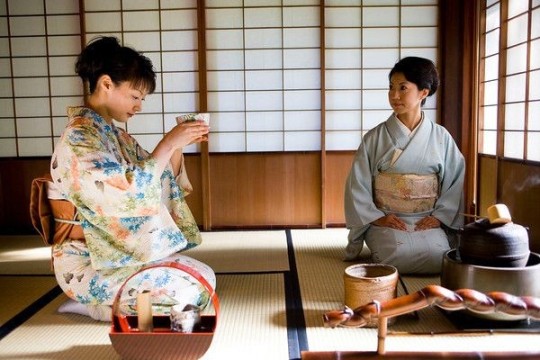
Values and Opinions are the bread and butter of any culture. This is the way your culture sees the world and how they approach different life hurdles. These may differ with other cultures and be considered odd to outsiders, what one culture may value another may not and what opinion another holds, one may not. There will be historical and traditional reasons to why these values and opinions are held. Cultures usually have a paragon to which they hold their members to, a list of characteristics that they expect one to if not adhere to then aspire to. The Yoruba people value honesty, hard work, courage and integrity. Here are some questions to consider?
How important are these ethics and core values? Could somebody be ostracised for not living up to them?
What are some morals that clash with other cultures?
What does your culture precieved to be right? Or wrong?
What are some opinions that are considered to be taboo in your culture? Why?
Dress Code
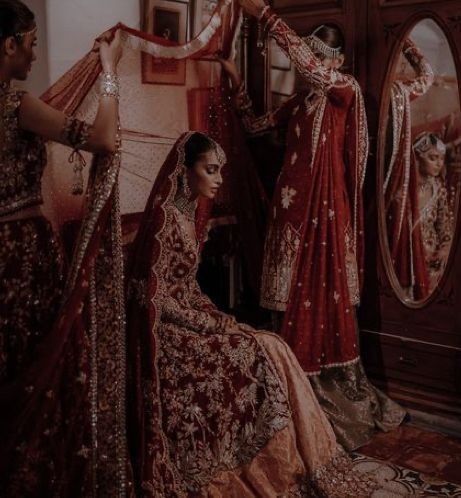
For many cultures, the way somebody dresses can be important. History and ethics can effect how one is meant to be dressed such as an expectation of chastity, can impose strict modesty. While other cultures, put more importance on details, the different sorts of clothes worn and when or what colour one might wear. The Palestinian people (من النهر إلى البحر ، قد يكونون أحرارا) denoted different family ties, marriage status and wealth by the embroidery and detailing on their thoub.
Are there traditional clothes for your world? Are they something somebody wears on a daily basis or just on occasion?
Are there any rules around what people can wear?
What would be considered formal dress? Casual dress?
What would happen if somebody wore the wrong clothes to an event?
Language

Language can also be ingrained as part of a Culture. It can be a specific way one speaks or a an entirely different language. For example, in the Southern States of America, one can engage in a sort of double talk, saying something that sounds sweet whilst delivering something pointed. Bless their heart. I have a post on creating your own language here.
Arts, Music and Craft

Many cultures are known for different styles of dance, their artwork and crafts. Art is a great part of culture, a way for people to express themselves and their culture in art form. Dance can be an integral part of culture, such as céilí dance in Ireland or the Polka in the Czech Republic. Handicrafts could also be important in culture, such as knitting in Scottish culture and Hebron glass in Palestine. Music is also close to culture, from traditional kinds of singing such as the White Voice in Ukraine and the playing of certain instruments such as the mvet.
Food and Diet

The way a culture prepares or intakes or treats certain foods are important to a culture. In some cultures, there is a diet yo adhere to, certain foods are completely banned. With Jewish culture, pork is prohibited along with fish such as sturgeon, along with shellfish and certain fowl. Meat must also be prepared in a certain way and animal byproducts such as dairy, must never be created or even eaten around this meat. This is known as kosher. The way one consumes food is also important to culture. In some cultures, only certain people may eat together. Some cultures place important on how food is eaten. In Nigerian culture, the oldest guests are served first usually the men before the women. In Japanese culture, one must say 'itadakimasu' (I recieve) before eating. Culture may also include fasting, periods of time one doesn't intake food for a specific reason.
What are some traditional dishes in your world?
What would be a basic diet for the common man?
What's considered a delicacy?
Is there a societal difference in diet? What are the factors that effect diet between classes?
Is there any influence from other cuisines? If not, why not? If so, to what extent?
What would a typical breakfast contain?
What meals are served during the day?
What's considered a comfort food or drink?
Are there any restrictions on who can eat what or when?
Are there any banned foods?
What stance does your world take on alcohol? Is it legal? Can anybody consume it?
Are there any dining customs? Are traditions?
Is there a difference in formal meals or casual meals? If so, what's involved?
Are there any gestures or actions unacceptable at the dinner table?
How are guests treated at meals? If they are given deference, how so?
#Fantasy Guide to Building A Culture#As promised#If I fail my German exam I'm blaming ye#Culture#Building a culture#Fantasy Guide#WorldBuilding#WorldBuilding guide#WorldBuilding help#Writing help#writing#writeblr#writing resources#writing reference#writing advice#ask answered questions#writers#writing advice writing resources#spilled ink#ask answered
10K notes
·
View notes
Text
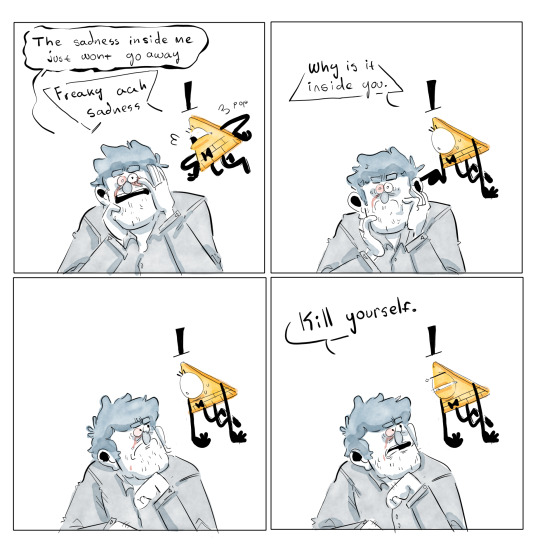
i think they're gonna make it, guys
src
#billford#stanford pines#bill cipher#gravity falls#the book of bill#writing a relationship guide book#gonna call it 'knives needles and poison: what YOU need to spice up your sex life'#hahaha just kidding . unless#stump art
1K notes
·
View notes
Text
25 Prose Tips For Writers 🖋️✨ Part 1
Hey there!📚✨
As writers, we all know that feeling when we read a sentence so beautifully crafted that it takes our breath away. We pause, reread it, and marvel at how the author managed to string those words together in such a captivating way. Well, today I'm going to unpack a few secrets to creating that same magic in your own writing. These same tips I use in my writing.
But before I begin, please remember that writing is an art form, and like any art, it's subjective. What sounds beautiful to one person might not resonate with another. The tips I'm about to share are meant to be tools in your writer's toolkit, not rigid rules. Feel free to experiment, play around, and find what works best for your unique voice and style.
Power of Rhythm 🎵
One of the most overlooked aspects of beautiful prose is rhythm. Just like music, writing has a flow and cadence that can make it pleasing to the ear (or mind's ear, in this case). Here are some ways to incorporate rhythm into your writing:
a) Vary your sentence length: Mix short, punchy sentences with longer, flowing ones. This creates a natural ebb and flow that keeps your reader engaged.
Example: "The sun set. Darkness crept in, wrapping the world in its velvet embrace. Stars winked to life, one by one, until the sky was a glittering tapestry of light."
b) Use repetition strategically: Repeating words or phrases can create a hypnotic effect and emphasize important points.
Example: "She walked through the forest, through the shadows, through the whispers of ancient trees. Through it all, she walked with purpose."
c) Pay attention to the stressed syllables: In English, we naturally stress certain syllables in words. Try to end important sentences with stressed syllables for a stronger impact.
Example: "Her heart raced as she approached the door." (Stronger ending) vs. "She approached the door as her heart raced." (Weaker ending)
Paint with Words 🎨
Beautiful prose often creates vivid imagery in the reader's mind. Here are some techniques to help you paint with words:
a) Use specific, concrete details: Instead of general descriptions, zoom in on particular details that bring a scene to life.
Example: Instead of: "The room was messy." Try: "Crumpled papers overflowed from the waste bin, books lay spine-up on every surface, and a half-eaten sandwich peeked out from under a stack of wrinkled clothes."
b) Appeal to all five senses: Don't just describe what things look like. Include smells, sounds, textures, and tastes to create a fully immersive experience.
Example: "The market bustled with life. Colorful fruits glistened in the morning sun, their sweet aroma mingling with the earthy scent of fresh herbs. Vendors called out their wares in sing-song voices, while customers haggled in animated tones. Sarah's fingers brushed against the rough burlap sacks of grain as she passed, and she could almost taste the tang of ripe oranges on her tongue."
c) Use unexpected comparisons: Fresh similes and metaphors can breathe new life into descriptions.
Example: Instead of: "The old man was very thin." Try: "The old man was a whisper of his former self, as if life had slowly erased him, leaving behind only the faintest outline."
Choose Your Words Wisely 📚
Every word in your prose should earn its place. Here are some tips for selecting the right words:
a) Embrace strong verbs: Replace weak verb + adverb combinations with single, powerful verbs.
Example: Instead of: "She walked quickly to the store." Try: "She hurried to the store." or "She dashed to the store."
b) Be specific: Use precise nouns instead of general ones.
Example: Instead of: "She picked up the flower." Try: "She plucked the daisy."
c) Avoid clichés: Clichés can make your writing feel stale. Try to find fresh ways to express common ideas.
Example: Instead of: "It was raining cats and dogs." Try: "The rain fell in sheets, transforming the streets into rushing rivers."
Play with Sound 🎶
The sound of words can contribute greatly to the beauty of your prose. Here are some techniques to make your writing more musical:
a) Alliteration: Repeating initial consonant sounds can create a pleasing effect.
Example: "She sells seashells by the seashore."
b) Assonance: Repeating vowel sounds can add a subtle musicality to your prose.
Example: "The light of the bright sky might ignite a fight."
c) Onomatopoeia: Using words that sound like what they describe can make your writing more immersive.
Example: "The bees buzzed and hummed as they flitted from flower to flower."
Art of Sentence Structure 🏗️
How you structure your sentences can greatly affect the flow and impact of your prose. Here are some tips:
a) Use parallel structure: When listing items or actions, keep the grammatical structure consistent.
Example: "She came, she saw, she conquered."
b) Try periodic sentences: Build suspense by putting the main clause at the end of the sentence.
Example: "Through storm and strife, across oceans and continents, despite all odds and obstacles, they persevered."
c) Experiment with sentence fragments: While not grammatically correct, sentence fragments can be powerful when used intentionally for emphasis or style.
Example: "She stood at the edge of the cliff. Heart racing. Palms sweating. Ready to jump."
Power of White Space ⬜
Sometimes, what you don't say is just as important as what you do. Use paragraph breaks and short sentences to create pauses and emphasize important moments.
Example: "He opened the letter with trembling hands.
Inside, a single word.
'Yes.'"
Read Your Work Aloud 🗣️
One of the best ways to polish your prose is to read it aloud. This helps you catch awkward phrasing, repetitive words, and rhythm issues that you might miss when reading silently.
Edit Ruthlessly ✂️
Beautiful prose often comes from rigorous editing. Don't be afraid to cut words, sentences, or even entire paragraphs if they don't serve the overall beauty and effectiveness of your writing.
Study the Masters 📖
Please! Read widely and pay attention to how your favorite authors craft their prose. Analyze sentences you find particularly beautiful and try to understand what makes them work.
Practice, Practice, Practice 💪
Like any skill, writing beautiful prose takes practice. Set aside time to experiment with different techniques and styles. Try writing exercises focused on specific aspects of prose, like describing a scene using only sound words, or rewriting a simple sentence in ten different ways.
Remember, that developing your prose style is a journey, not a destination. It's okay if your first draft isn't perfect – that's what editing is for! The most important thing is to keep writing, keep experimenting, and keep finding joy in the process.
Here are a few more unique tips to help you on your prose-perfecting journey:
Create a Word Bank 🏦
Keep a notebook or digital file where you collect beautiful words, phrases, or sentences you come across in your reading. This can be a great resource when you're looking for inspiration or the perfect word to complete a sentence.
Use the "Rule of Three" 3️⃣
There's something inherently satisfying about groups of three. Use this to your advantage in your writing, whether it's in listing items, repeating phrases, or structuring your paragraphs.
Example: "The old house groaned, creaked, and whispered its secrets to the night."
Power of Silence 🤫
Sometimes, the most powerful prose comes from what's left unsaid. Use implication and subtext to add depth to your writing.
Example: Instead of: "She was heartbroken when he left." Try: "She stared at his empty chair across the breakfast table, the untouched coffee growing cold."
Play with Perspective 👁️
Experiment with different points of view to find the most impactful way to tell your story. Sometimes, an unexpected perspective can make your prose truly memorable.
Example: Instead of describing a bustling city from a human perspective, try describing it from the point of view of a bird soaring overhead, or a coin passed from hand to hand.
Use Punctuation Creatively 🖋️
While it's important to use punctuation correctly, don't be afraid to bend the rules a little for stylistic effect. Em dashes, ellipses, and even unconventional use of periods can add rhythm and emphasis to your prose.
Example: "She hesitated—heart pounding, palms sweating—then knocked on the door."
Create Contrast 🌓
Juxtapose different elements in your writing to create interest and emphasis. This can be in terms of tone, pacing, or even the literal elements you're describing.
Example: "The delicate butterfly alighted on the rusted barrel of the abandoned tank."
Use Synesthesia 🌈
Synesthesia is a condition where one sensory experience triggers another. While not everyone experiences this, using synesthetic descriptions in your writing can create vivid and unique imagery.
Example: "The violin's melody tasted like honey on her tongue."
Experiment with Sentence Diagrams 📊
Remember those sentence diagrams from school? Try diagramming some of your favorite sentences from literature. This can give you insight into how complex sentences are structured and help you craft your own.
Create a Sensory Tour 🚶♀️
When describing a setting, try taking your reader on a sensory tour. Move from one sense to another, creating a full, immersive experience.
Example: "The old bookstore welcomed her with the musty scent of aging paper. Dust motes danced in the shafts of sunlight piercing the high windows. Her fingers trailed over the cracked leather spines as she moved deeper into the stacks, the floorboards creaking a greeting beneath her feet. In the distance, she could hear the soft ticking of an ancient clock and taste the faint bitterness of old coffee in the air."
Use Active Voice (Most of the Time) 🏃♂️
While passive voice has its place, active voice generally creates more dynamic and engaging prose. Compare these two sentences:
Passive: "The ball was thrown by the boy." Active: "The boy threw the ball."
Magic of Ordinary Moments ✨
Sometimes, the most beautiful prose comes from describing everyday occurrences in a new light. Challenge yourself to find beauty and meaning in the mundane.
Example: "The kettle's whistle pierced the quiet morning, a clarion call heralding the day's first cup of possibility."
Play with Time ⏳
Experiment with how you present the passage of time in your prose. You can stretch a moment out over several paragraphs or compress years into a single sentence.
Example: "In that heartbeat between his question and her answer, universes were born and died, civilizations rose and fell, and their entire future hung in the balance."
Use Anaphora for Emphasis ��
Anaphora is the repetition of a word or phrase at the beginning of successive clauses or sentences. It can create a powerful rhythm and emphasize key points.
Example: "She was the sunrise after the longest night. She was the first bloom of spring after a harsh winter. She was the cool breeze on a sweltering summer day. She was hope personified, walking among us."
Create Word Pictures 🖼️
Try to create images that linger in the reader's mind long after they've finished reading. These don't have to be elaborate – sometimes a simple, unexpected combination of words can be incredibly powerful.
Example: "Her laughter was a flock of birds taking flight."
Use Rhetorical Devices 🎭
Familiarize yourself with rhetorical devices like chiasmus, antithesis, and oxymoron. These can add depth and interest to your prose.
Example of chiasmus: "Ask not what your country can do for you – ask what you can do for your country." - John F. Kennedy
Even the most accomplished authors continue to hone their craft with each new piece they write. Don't be discouraged if your first attempts don't sound exactly like you imagined – keep practicing, keep experimenting, and most importantly, keep writing.
Your unique voice and perspective are what will ultimately make your prose beautiful. These techniques are simply tools to help you express that voice more effectively. Use them, adapt them, or discard them as you see fit. The most important thing is to write in a way that feels authentic to you and brings you joy.
Happy writing, everyone! 🖋️💖📚 - Rin T
Hey fellow writers! I'm super excited to share that I've just launched a Tumblr community. I'm inviting all of you to join my community. All you have to do is fill out this Google form, and I'll personally send you an invitation to join the Write Right Society on Tumblr! Can't wait to see your posts!
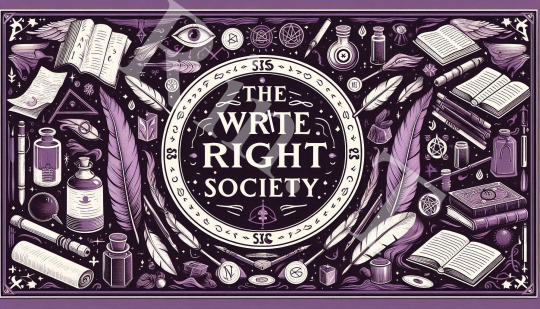
#writing tips#on writing#creative writing#writers block#writing#how to write#thewriteadviceforwriters#writers and poets#writers on tumblr#writeblr#aspiring author#author#book writing#indie author#writer#indie writer#authors of tumblr#fiction writing#writing a book#writing advice#writing blog#writing community#writing guide#writing help#writing characters#writing ideas#writing inspiration#novel writing#romance writing#writing reference
2K notes
·
View notes
Text
I think a thing that people get wrong about Jason's anger is that it's not explosive.
It's cold. Jason isn't the type of person who storms off at every little thing or goes throwing tantrums and setting things on fire blindfully.
He's the type of person who's very practical. He keeps to himself, always. You rarely see issues where Jason's anger is reactive at the moment where the trigger happens to him. If you see his character up close, most of the time when he's triggered his reaction is calm. Even cold.
He gets triggered -> He keeps to himself → He makes a plan → And then he reacts.
Jason's anger being something explosive and out of character and out of place is actually how other people (characters) see it, because they have no idea on how it's playing out on Jason's head.
And that's a thing you can see operating since he was a child.
Where the only exceptions about this effect is either when someone he believes needs his help is involved.
See Nightwing Annual (2021)
But In Batman #411 when Jason learns the fact that Two-Face was responsible for his father's death and Bruce was keeping that from him as a secret his first reaction isn't to blow up on him.
Was to seethe.
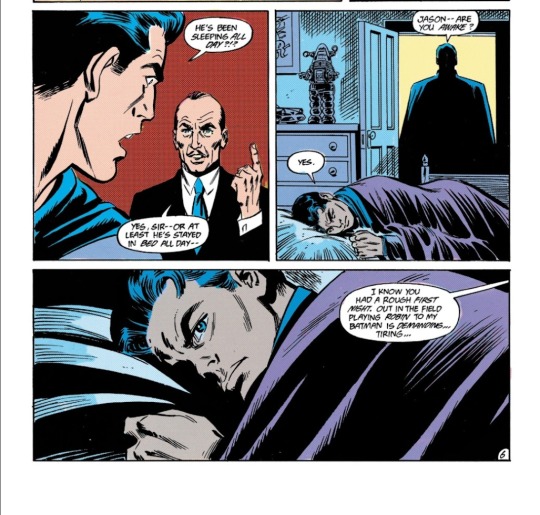
Bruce goes up home after dealing with a Two-Face case (in my field we call that poetic irony) and asks Alfred where Jason is, Alfred's answer is that he's been sleeping all day (which is a conclusion that Alfred drew probably after going to check on Jason and seeing him in fact on his bed all day).
But when you see the next panel, even though he is on the bed, He's fully awake and both his expression and his body language shows that he's in fact angry.
This is the first time he appears again in the comics after learning that Two Face killed his dad.
Jason doesn't go towards Bruce immediately to demand an explanation or ask why he did this, or even to throw the truth on his face.
(Which could be debatable that that's something the Dick would usually do, but I'm not that literate on Dick's comics)
His reaction wasn't immediate.
His reaction was to go to his bed and stay quiet. Jason stayed calm and collected the whole trip until meeting Two Face again.
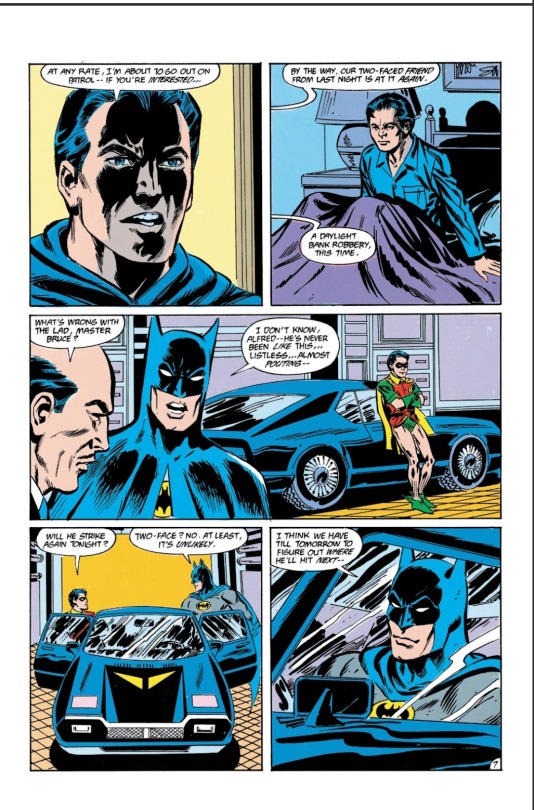
But the moment Jason as Robin has the opportunity to get his hands on Two-Face he does this

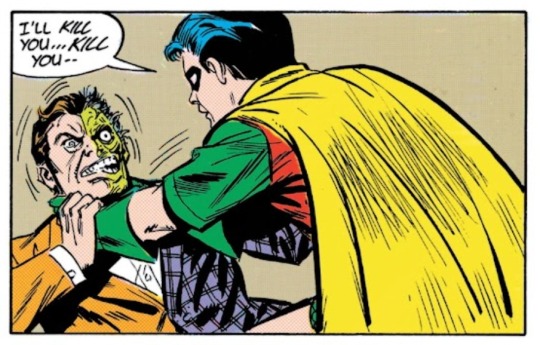
From Bruce, and maybe Alfred's perspective it could be interpreted as out of place or him storming off.
But it isn't. Jason was able to keep his cool (even though he shut off), until he was face a face to Two Face.
Does that mean he planned that to happen?
That's debatable, in any moment of this issue it is shown that Jason was actually planning to get to Two Face and do this. I my personal opinion, other and much more plausible explanation is: That he was in fact trying to keep to himself but couldn't hold back the moment that he saw his dad's murder.
You can see the same thing happening as Jason learns that Batman got another Robin in Red Hood: Lost Days.

Talia asks "You all right?" and Jason's first answer is "Sure Why Wouldn't I Be Alright?"
When he's alone he finally has the moment to break down.
(Actually both Red Hood: The lost days and Batman: Under the Red Hood are great case studies on how that usually play out on Jason's head.)
Jason is way more in control of his emotions than people ever give him credit for. The thing is that Jason holds it back until he either blows off or is capable to throw it back in someone's face.
#I didn't finish not even half of my thoughts in here but I'm going to publish it before it gets drag in my 182828383 drafts#if you disagree lets fist fight at six am#jason todd#q rambles#character study#writing Jason Todd#← this is not a guide this is literally the tag I use to organize things#q screams at the void#q rants
6K notes
·
View notes
Text
an actual guide to british slang for foreign marauders writers.
because i am sick of seeing
a) people using american english eg. mom, sneakers
b) people overusing "mate" and "innit"
alright? = a greeting, like hello.
everyday words
ain't = haven't
scran = food, or to describe eating
swear down = promise
"swear down, I didn't do nothing,"
bloody = can be used in any sentence at any time
"bloody hell" "its bloody pissing it down out there" "i was bloody wankered"
bloke = a man
innit = isn't it?
mate = equivalent of calling someone bro
bruv, lad, my son = bro, dude, etc
fags, rollies, ciggies, (NOT A SPLIFF) = cigarettes
trust = trust me
"trust, ill tell you later"
chatting (what you chatting about?) = what are you on about?
quid = pound
proper buzzing = really excited
good
sound = good
bangin' = really good
lush = good
"that scran was lush"
jokes = a laugh, funny
bare = a lot of
fit = physically attractive
"he's well fit, isn't he?"
pissed = drunk
dodgy/dodge = questionable
bad
are you taking the piss? = are you having a laugh?
thats peak = thats bad
not being funny, but... = no offense but...
gordon bennett! = surprise, shock, disbelief
slag off = talk badly about someone
"she was slagging her off to anyone who'd listen"
minging, rank = disgusting
bloody nora = expression of surprise, irritation
bollocks = nonsense, something bad
"stop talking bollocks, mate"
skint = broke
prat, git = an idiot
insults
a melt = a pathetic person
clapped = ugly
"he's fucking clapped..."
sket = a promiscuous woman
slag = ^^
minger = an unattractive person
plonker = calling someone silly, not offensive
"don't be a plonker..."
cunt = VERY OFFENSIVE!
wanker, tosser = a general insult
bender, poof = a gay man, used insultingly
#marauders#the marauders#british slang#slang#fanfic#writing guide#writing help#help#writing advice#jegulus#starchaser#wolfstar
3K notes
·
View notes
Text
I keep seeing people say things like this: "You know what does matter to the politicians, even more than us voting for them? When we DON’T vote for them."
No, absolutely not. This is not how the US electoral system works. Under the current system, only votes cast matter. Only people who are going to vote matter to campaign strategists.
The last election, less than 20% of my district voted. The 80+% of the people who abstained? Their opinions on the results don't matter. The system does not take them into account. They gave up their right to have a say. Some strategists for future elections might look at the numbers and say: wow, why didn't those people vote, and can we GET them to vote? But ultimately, the system is designed so that if only one person votes, that person gets to decide the winning candidate. You get the representatives voted on by whoever shows up to the poll.
If a candidate thinks you cannot be swayed to vote (because, for example, you've joined a weird anti-voting movement), then ther campaign is not going to cater to you. Their strategists won't care about you. Someone in the next cycle might try for your vote, but you are giving up your right to have a voice for this cycle.... and voters with a history of voting are more promising targets for any campaign strategies.
(Your actual vote is a secret, but they DO monitor that you have voted. This will affect how much annoying campaigning materials you will get, because they do target active voters.)
Also, "if I don't vote, that will make a point!" is just a stupid take in general. If you don't vote in November, and then Trump wins, what have you really done? Do you think the Biden admin will care, as they're leaving office? Do you think the Trump admin will care, as they enter office? Republicans want fewer people to vote! Your abstention will be nothing but a footnote in history about how Trump won.
#'is this vote shaming?' this is a made up and useless term#voting is your RIGHT which i encourage you to USE. i will never encourage you to give up your rights.#i would yell at you to vote even in a less important election#i yell at coworkers and friends every november!!#(actually i just write up a voting guide for our area. but same mood)#greatest hits
3K notes
·
View notes
Text
oh to be a shivering little floret in my Mistress's vines~
all drugged out and soft on Class A's
suddenly my mistress chuckles "oh pet! We haven't given you your Class G's yet today have we?"
And she holds her flower just above my arm, just barely touching skin
"Do you want them, petal? Why don't you take them?"
and I try to lift my arm up so the needle breaks the skin but then my Mistress's writhe underneath me and I fall, useless and limp against them again.
She looks at me with so much love and asks "oh pet, what's the matter? I thought you liked your new body?"
All I can do is look up at her and whisper "please..." my whisper drawing out into a whine as my Mistress shudders and plunges herself into me, flower petals wrapped around my arm so I couldn't shake it even I wanted to, pumping me so full of girl juice.
"What a good little pet, begging so sweetly," she croons. "You're going to be such a good little girl for me~"
#don't usually write smut here#but uhhh#human domestication guide#has me feeling some kinda way obviously ;~;#so sorry not sorry I guess :P#not ready to write a full fic but needed to get this out my system#smut#hdg#just pet thoughts
719 notes
·
View notes
Text
writing tip - research
research is one of the pillars of writing. a poorly researched fic, essay, short story, novel, etc is immediately apparent because of several things:
lack of depth
stagnant plot or development
confusing or inconsistent setting
it doesn't matter what genre you write, if it's original or fiction, whatever. you need to research. depending on the relevance of your writing, the depth of research may vary, but it needs to happen. you do not know everything.
Fantasy
I see a lot of writers and authors use fantasy as an excuse to avoid research. Shut the fuck up. Every good fantasy is based on a real ocurrence or social dilemma. That's why we like it so much.
'but pygmi, fantasy is made up! it isn't real!'
SHUT UP. Even if you don't realize it, your story will have elements that readers are intimately familiar with. If you flub something, it will be noticed.
Besides, just because you make stuff up doesn't mean you can be inconsistent. You'll just have to fill in the cracks with made up stuff, which will even out to being about the same amount of effort. Pick your poison, either way you're gonna feel it.
Research is not everybody's favorite. I like it, personally, I think it's like going on little side quests for knowledge. But I understand if you wanna skip all the business and get to writing your baby. No shame.
Let me give you some pointers to make sure the time you spend researching is relevant and well spend.
Lists! God I love lists. after you have outlined your story and your characters and everything, make a list of all the things you need to have a deeper understanding of. This means determining priorities. - How important is The Thing? Will it majorly affect plot or character development? Is it a focal point of the setting? If the answer is yes to any of those questions, it's important. research.
Big picture, little picture. How important is The Thing (again)?. How much detail do you need to know? Especially when it comes to royalty or a hierarchal system, I see research being misguided. There are so many nuances to royal interactions that I could give a rat's ass. Big picture, general outline. I don't need to know everything, just basic courtesy, terms of address, appropriate convo. done. but if your MC is a coroner? might wanna put more detail into that; you'll be talking about the job a lot. determine how much the element will affect your story and go from there.
Don't fudge it for the plot. You'll have a preconceived notion of a certain job description, and then research it and think 'oh that's actually boring.' Don't muddle up the rules just to fit the aesthetic. It's sloppy, and your readers will notice.
To practice researching, pick your topic and after learning a bit about it, try teaching a powerpoint to your parents or friends. if you feel comfortable enough with that knowledge to do it successfully, I'd say you have a good enough understanding.
Setting
researching location is a big one that often gets overlooked. You don't always need to memorize maps, but get a general idea of the city/country layout so when you say "they drove 20 minutes from A to B" it makes sense, rather than having a reader think "Uh, A to B is closer to four hours, wtf?"
if you are making up your city, make a list of important streets and locations in relation to each other. This will help you keep it straight and organized in your head.
Get a feel for flora and fauna. Palm trees don't grow in Alaska. Don't write an Alaskan city with palm trees.
Weather? what's it like? Let me tell you, Portland doesn't get higher than 102F. rainy, cloudy, all that stuff.
Atmospheric details really add a lot, especially if your audience is from that location. It adds another layer of relatability. Also, use weather/plants/animals to your advantage! symbolism, possible curse, all that stuff.
Eras
Oh my god stop fucking this up. Baroque, Elizabethan, Edwardian, Middle Ages ARE DIFFERENT FROM EACH OTHER. STOP SLAPPING FANCY CLOTHES ON PEOPLE AND CALLING IT THE OLDEN DAYS.
get an idea of when electricity was widespread in homes. when was the refrigerator invented? did they use the word 'hella' in 1950? this kinda stuff is important for not breaking the illusion of a time difference. If you are writing a period piece and someone is chatting with a neighbor like it's 2015, we'll have some questions.
Unless it's doctor who. you guys can do literally whatever.
Plot and Character Development
If plot and characters are poorly researched, you are limiting the opportunities for growth. In researching your MC's occupation, you may discover a cool side effect that connects to a plot device. Stagnant, stale characters can be spruced up with a more developed backstory.
All in all, research is really important for your story. regardless of how professional it is, tumblr or the new york times. Do your research. As a writer, you are representing the community in your own way. Do us proud.
xox love you
#writing tips#writing advice#fanfiction#writing help#descriptive writing#fic writing#writer#research#research guide#tumblr writing society#writeblr#creative writing#writing community#writers on tumblr
792 notes
·
View notes
Text
Vox Drawing Guides!
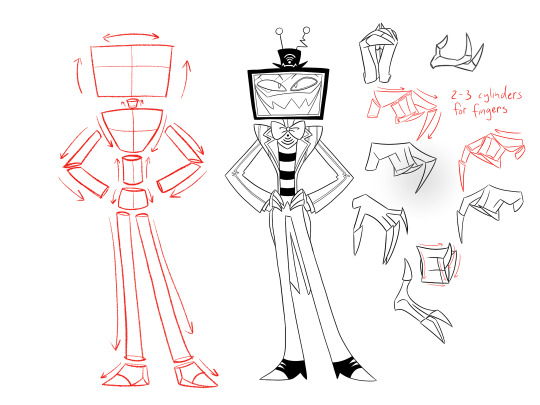

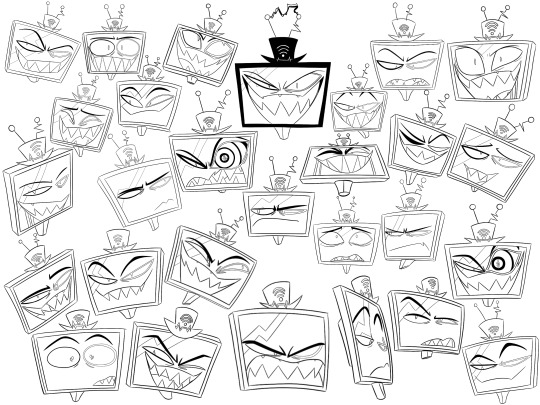
I think I'm going to do one more expression page for him because, despite having the simplest shaped head, I have such a hard time drawing him T.T
Link to Masterpost with my other drawing guides
#I love how expression Vox is#hahah so many different looks#he's such a goofball#I love him so much#him and his stupidly flat face (affectionate)#I really need to draw/write some RadioStatic#because they are on my mind 24/7#hazbin hotel#vox hazbin hotel#hazbin vox#hazbin hotel vox#vox#art#drawing guides
2K notes
·
View notes
Text
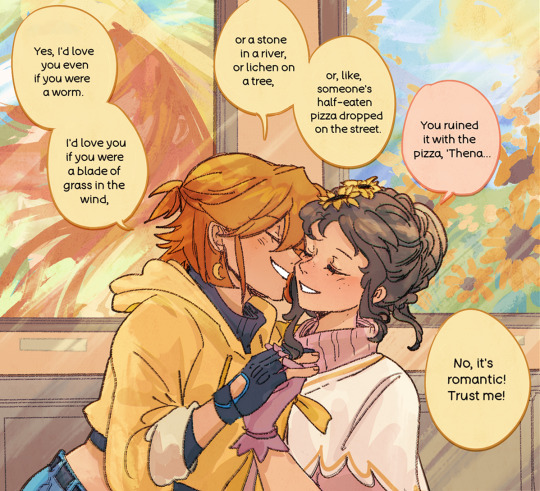
day 10: love is devotion ♡
(femslashfeb prompt list)
#minifemslashfeb2024#ace attorney#junithena#athena cykes#juniper woods#melts into a puddle#junithena WARM junithena SOFT#junithena is so darling to me especially the version of it I made up in my head#ok I always write junie with imposter syndrome BUT#can we talk about how many skills this girl has. she can knit. she can sing. she can write. she can garden. she's smart#AND she's studying law to become a judge#I made her a painter for this too. because why not#god gave her health problems to nerf her. otherwise she would be too powerful#also athena short hair swag because I think she looks cute like that#do you ever think about the space and earth symbolism? no? just me?#is there something quite so intangible as falling in love with the stars#believing you will never reach them#when the stars are shining brightly to guide your way#they shine just for you...#mini be normal about junithena challenge: failed#'what are you talking about' shhh. shh.#you are safe now my sweet child
1K notes
·
View notes
Text
The Mini Guide to Crafting Compelling Royal Characters for Fiction Writers
Creating royal characters can be both exciting and challenging. These regal figures often play pivotal roles in stories, capturing readers' imaginations with their power, privilege, and the weight of responsibility they carry. Whether you're writing historical fiction, fantasy, or contemporary novels featuring monarchs, this comprehensive (mini) guide will help you develop authentic, multi-dimensional royal characters that will resonate with your readers.
Understanding the Basics of Royalty
Before diving into character creation, it's essential to have a solid grasp of what royalty entails. Royalty typically refers to members of a ruling family, including kings, queens, princes, princesses, and other nobles within a monarchical system. These individuals are often born into their roles, though some may ascend to power through marriage or other means.
Key aspects to consider:
Hierarchy and succession
Royal duties and responsibilities
Protocol and etiquette
The concept of divine right (in some cultures)
The relationship between royalty and their subjects
Remember, while these elements are common in many royal systems, you have the creative freedom to adapt or reimagine them for your fictional world.
Developing Your Royal Character's Background
Every character, royal or not, needs a rich backstory. For royal characters, this background is particularly crucial as it shapes their worldview, values, and decision-making processes.
Consider the following:
a) Lineage: What is your character's family history? Are they from a long-standing dynasty or a newly established royal house?
b) Upbringing: How were they raised? Were they groomed for leadership from birth, or did they have a more sheltered upbringing?
c) Education: What kind of education did they receive? Was it formal, focusing on statecraft and diplomacy, or more well-rounded?
d) Relationships: How do they relate to their family members, courtiers, and subjects?
e) Personal experiences: What significant events have shaped their character and outlook on life?
Crafting a Unique Personality
Avoid the trap of creating one-dimensional royal stereotypes. Your character should be as complex and nuanced as any other well-developed protagonist or antagonist.
Consider these aspects:
a) Strengths and weaknesses: What are your character's admirable qualities? What flaws do they struggle with?
b) Motivations: What drives them? Is it a sense of duty, personal ambition, or something else entirely?
c) Internal conflicts: What personal struggles do they face? How do these conflicts affect their rule and relationships?
d) Hobbies and interests: What passions do they pursue outside of their royal duties?
e) Sense of humor: How do they express humor, if at all? Is it dry wit, sarcasm, or something else?
Balancing Power and Vulnerability
One of the most intriguing aspects of royal characters is the juxtaposition between their immense power and their human vulnerabilities. This balance can create compelling internal and external conflicts for your character.
Consider:
The weight of responsibility and its impact on their personal life
The isolation that often comes with a royal position
The constant scrutiny they face from the public and court
The struggle between personal desires and duty to the crown
Creating a Believable Royal World
Your royal character doesn't exist in a vacuum (I hope not). They're part of a larger royal ecosystem that includes family members, advisors, courtiers, and subjects. Developing this world adds depth and authenticity to your story.
Key elements to consider:
Court dynamics and politics
Relationships with other noble houses or kingdoms
The role of advisors and how they influence decisions
Traditions and customs specific to your royal setting
The economic and social structure of the kingdom
Addressing the Challenges of Royal Life
Royal characters face unique challenges that can drive your plot and character development. Some common themes include:
a) Succession disputes b) Balancing personal happiness with duty c) Navigating political alliances and conflicts d) Managing public opinion and maintaining legitimacy e) Dealing with threats to their rule or life
Use these challenges to create tension and drive your story forward while revealing more about your character's personality and values.
The Impact of Historical Context
If you're writing historical fiction or a fantasy inspired by real-world monarchies, it's crucial to consider the historical context. Research the time period and culture you're drawing from to ensure authenticity in your character's behavior, beliefs, and challenges.
Key areas to research:
Social norms and expectations of the time
Political systems and power structures
Technology and its impact on governance
Religious beliefs and their influence on royalty
Gender roles and how they affect royal duties and succession
Avoiding Common Pitfalls
When creating royal characters, be mindful of these common mistakes:
a) Making them too perfect or too villainous b) Ignoring the realities of royal life (e.g., lack of privacy, constant duties) c) Overlooking the impact of their decisions on their subjects d) Failing to show growth or change over the course of the story e) Relying too heavily on stereotypes or clichés
Incorporating Royal Etiquette and Protocol
Royal characters often adhere to strict codes of conduct and protocol. While you don't need to become an expert in royal etiquette, incorporating some of these elements can add authenticity to your story:
Forms of address (Your Majesty, Your Highness, etc.)
Court ceremonies and rituals
Dress codes and regalia
Rules of precedence in social situations
Diplomatic protocols when interacting with other royals or dignitaries
Exploring Different Types of Royal Characters
Remember that not all royal characters need to be ruling monarchs. Consider exploring other royal roles, such as:
The rebel prince or princess who rejects their royal duties
The reluctant heir thrust into power unexpectedly
The exiled royal fighting to reclaim their throne
The royal spouse adapting to life in the palace
The illegitimate child discovering their royal heritage
Each of these archetypes offers unique storytelling opportunities and challenges for character development.
Balancing Historical Accuracy and Creative License
If you're writing historical fiction featuring real royalty, you'll need to strike a balance between historical accuracy and creative interpretation. While it's important to respect known facts and timelines, you also have the freedom to explore the inner lives and motivations of these historical figures.
Tips for balancing accuracy and creativity:
Thoroughly research the historical figure and their time period
Clearly differentiate between historical fact and fictional interpretation
Use author's notes to explain any significant departures from known history
Focus on filling in the gaps in the historical record rather than contradicting established facts
Developing Royal Character Arcs
Like any well-rounded character, your royal protagonist should undergo growth and change throughout your story. Consider how their experiences might challenge their beliefs, alter their perspective, or force them to confront their flaws.
Possible character arcs for royal characters:
From naive idealist to pragmatic ruler
From reluctant heir to confident leader
From isolated monarch to connected leader who understands their subjects
From power-hungry tyrant to benevolent ruler (or vice versa)
Remember, character growth doesn't always have to be positive. Sometimes, the most compelling stories involve characters who face moral decline or tragic falls from grace.
Remember, while the trappings of royalty may be grand, at their core, your royal characters are still human. They love, fear, hope, and struggle like anyone else. It's this humanity, set against the backdrop of power and responsibility, that makes royal characters so fascinating to read and write about.
Happy writing, - Rin T
Hey fellow writers! I'm super excited to share that I've just launched a Tumblr community. I'm inviting all of you to join my community. All you have to do is fill out this Google form, and I'll personally send you an invitation to join the Write Right Society on Tumblr! Can't wait to see your posts!

#writing#creative writing#thewriteadviceforwriters#writing tips#writers block#writeblr#how to write#writers and poets#writers on tumblr#on writing#royalcore#royalty#romance writing#writing advice#writing blog#writing guide#writing inspiration#writing ideas#writing reference#writing resources#writing software#writing tools#writer#writing life#writing help#writing community#writing characters#novel writing#fiction writing#writing a book
2K notes
·
View notes